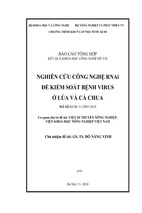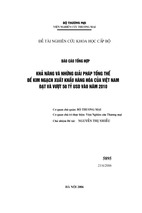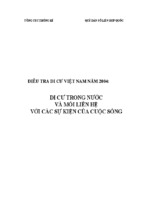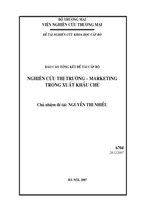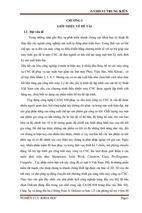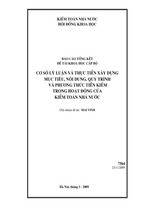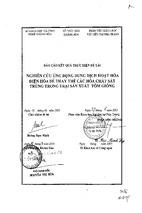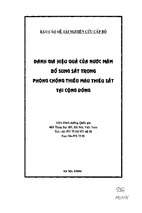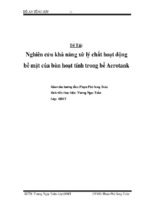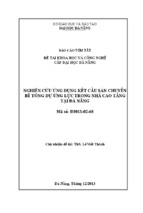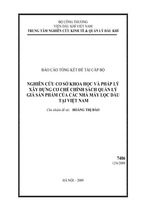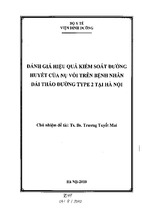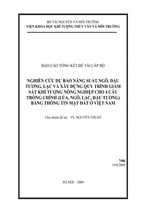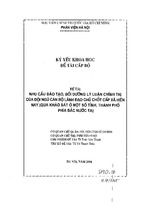Annals of Mathematics
A topological Tits
alternative
.
By E. Breuillard and T. Gelander
Annals of Mathematics, 166 (2007), 427–474
A topological Tits alternative
By E. Breuillard and T. Gelander
Abstract
Let k be a local field, and Γ ≤ GLn (k) a linear group over k. We prove
that Γ contains either a relatively open solvable subgroup or a relatively dense
free subgroup. This result has applications in dynamics, Riemannian foliations
and profinite groups.
Contents
1. Introduction
2. A generalization of a lemma of Tits
3. Contracting projective transformations
4. Irreducible representations of non-Zariski connected algebraic groups
5. Proof of Theorem 1.3 in the finitely generated case
6. Dense free subgroups with infinitely many generators
7. Multiple fields, adelic versions and other topologies
8. Applications to profinite groups
9. Applications to amenable actions
10. The growth of leaves in Riemannian foliations
References
1. Introduction
In his celebrated 1972 paper [35] J. Tits proved the following fundamental dichotomy for linear groups: Any finitely generated1 linear group contains
either a solvable subgroup of finite index or a non-commutative free subgroup.
This result, known today as “the Tits alternative”, answered a conjecture of
Bass and Serre and was an important step toward the understanding of linear
groups. The purpose of the present paper is to give a topological analog of
this dichotomy and to provide various applications of it. Before stating our
1
In characteristic zero, one may drop the assumption that the group is finitely generated.
428
E. BREUILLARD AND T. GELANDER
main result, let us reformulate Tits’ alternative in a slightly stronger manner.
Note that any linear group Γ ≤ GLn (K) has a Zariski topology, which is, by
definition, the topology induced on Γ from the Zariski topology on GLn (K).
Theorem 1.1 (The Tits alternative). Let K be a field and Γ a finitely
generated subgroup of GLn (K). Then Γ contains either a Zariski open solvable
subgroup or a Zariski dense free subgroup of finite rank.
Remark 1.2. Theorem 1.1 seems quite close to the original theorem of
Tits, stated above. And indeed, it is stated explicitly in [35] in the particular case when the Zariski closure of Γ is assumed to be a semisimple Zariski
connected algebraic group. However, the proof of Theorem 1.1 relies on the
methods developed in the present paper which make it possible to deal with
non-Zariski connected groups. We will show below how Theorem 1.1 can be
easily deduced from Theorem 1.3.
The main purpose of our work is to prove the analog of Theorem 1.1, when
the ground field, and hence any linear group over it, carries a more interesting
topology than the Zariski topology, namely for local fields.
Assume that k is a local field, i.e. R, C, a finite extension of Qp , or a
field of formal power series in one variable over a finite field. The full linear
group GLn (k), and hence also any subgroup of it, is endowed with the standard
topology, that is the topology induced from the local field k. We then prove
the following:
Theorem 1.3 (Topological Tits alternative). Let k be a local field and
Γ a subgroup of GLn (k). Then Γ contains either an open solvable subgroup or
a dense free subgroup.
Note that Γ may contain both a dense free subgroup and an open solvable
subgroup: in this case Γ has to be discrete and free. For nondiscrete groups
however, the two cases are mutually exclusive.
In general, the dense free subgroup from Theorem 1.3 may have an infinite
(but countable) number of free generators. However, in many cases we can find
a dense free subgroup on finitely many free generators (see below Theorems 5.1
and 5.8). This is the case, for example, when Γ itself is finitely generated. For
another example consider the group SLn (Q), n ≥ 2. It is not finitely generated,
yet, we show that it contains a free subgroup of rank 2 which is dense with
respect to the topology induced from SLn (R). Similarly, for any prime p ∈ N,
we show that SLn (Q) contains a free subgroup of finite rank r = r(n, p) ≥ 2
which is dense with respect to the topology induced from SLn (Qp ).
When char(k) = 0, the linearity assumption can be replaced by the
weaker assumption that Γ is contained in some second-countable k-analytic
Lie group G. In particular, Theorem 1.3 applies to subgroups of any real
A TOPOLOGICAL TITS ALTERNATIVE
429
Lie group with countably many connected components, and to subgroups of
any group containing a p-adic analytic pro-p group as an open subgroup of
countable index. In particular it has the following consequence:
Corollary 1.4. Let k be a local field of characteristic 0 and let G be a
k-analytic Lie group with no open solvable subgroup. Then G contains a dense
free subgroup F . If additionally G contains a dense subgroup generated by k
elements, then F can be taken to be a free group of rank r for any r ≥ k.
Let us indicate how Theorem 1.3 implies Theorem 1.1. Let K be a field,
Γ ≤ GLn (K) a finitely generated group, and let R be the ring generated by
the entries of Γ. By the Noether normalization theorem, R can be embedded
in the valuation ring O of some local field k. Such an embedding induces an
embedding i of Γ into the linear profinite group GLn (O). Note also that the
topology induced on Γ from the Zariski topology of GLn (K) coincides with the
one induced from the Zariski topology of GLn (k) and this topology is weaker
than the topology induced by the local field k. If i(Γ) contains a relatively open
solvable subgroup then so does its closure, and by compactness, it follows that
Γ is virtually solvable, and hence its Zariski connected component is solvable
and Zariski open. If i(Γ) does not contain an open solvable subgroup then, by
Theorem 1.3, it contains a dense free subgroup which, as stated in a paragraph
above, we may assume has finite rank. This free subgroup is indeed Zariski
dense.
The dichotomy established in Theorem 1.3 strongly depends on the choice
of the topology (real, p-adic, or Fq ((t))-analytic) assigned to Γ and on the embedding of Γ in GLn (k). It can be interesting to consider other topologies as
well. However, the existence of a finitely generated dense free subgroup, under
the condition that Γ has no open solvable subgroup, is a rather strong property
that cannot be generalized to arbitrary topologies on Γ (for example the profinite topology on a surface group; see §1.1 below). Nevertheless, making use
of the structure theory of locally compact groups, we show that the following
weaker dichotomy holds:
Theorem 1.5. Let G be a locally compact group and Γ a finitely generated
dense subgroup of G. Then one of the following holds:
(i) Γ contains a free group F2 on two generators which is nondiscrete in G.
(ii) G contains an open amenable subgroup.
Moreover , if Γ is assumed to be linear, then (ii) can be replaced by (ii)� “G
contains an open solvable subgroup”.
The first step toward Theorem 1.3 was carried out in our previous work [4].
In [4] we made the assumption that k = R and the closure of Γ is connected.
430
E. BREUILLARD AND T. GELANDER
This considerably simplifies the situation, mainly because it implies that Γ is
automatically Zariski connected. One achievement of the present work is the
understanding of some dynamical properties of projective representations of
non-Zariski connected algebraic groups (see §4). Another new aspect is the
study of representations of finitely generated integral domains into local fields
(see §2) which allows us to avoid the rationality of the deformation space of Γ
in GLn (k), and hence to drop the assumption that Γ is finitely generated.
For the sake of simplicity, we restrict ourselves throughout most of this
paper to a fixed local field. However, the proof of Theorem 1.3 applies also in
the following more general setup:
Theorem 1.6. Let k1 , k2 , . . . , kr be local fields and let Γ be a subgroup
�r
(resp. finitely generated subgroup) of
i=1 GLn (ki ). Assume that Γ does not
contain an open solvable subgroup. Then Γ contains a dense free subgroup
(resp. of finite rank ).
Recall that in this statement, as everywhere else in the paper, the group
Γ is viewed as a topological group endowed with the induced topology coming
from the local fields k1 , k2 , . . . , kr .
We also note that the argument of Section 6, where we build a dense free
group on infinitely many generators, is applicable in a much greater generality.
For example, we can prove the following adelic version:
Proposition 1.7. Let K be an algebraic number field and G a simply
connected semisimple algebraic group defined over K. Let VK be the set of all
valuations of K. Then for any v0 ∈ VK such that G in not Kv0 anisotropic,
G(K) contains a free subgroup of infinite rank whose image under the diagonal embedding is dense in the restricted topological product corresponding to
VK \ {v0 }.
Theorem 1.3 has various applications. We shall now indicate some of
them.
1.1. Applications to the theory of profinite groups. When k is nonArchimedean, Theorem 1.3 provides some new results about profinite groups
(see §8). In particular, we answer a conjecture of Dixon, Pyber, Seress and
Shalev (cf. [12] and [25]), by proving:
Theorem 1.8. Let Γ be a finitely generated linear group over an arbitrary
field. Suppose that Γ is not virtually solvable. Then its profinite completion Γ̂
contains a dense free subgroup of finite rank.
In [12], using the classification of finite simple groups, the weaker statement, that Γ̂ contains a free subgroup whose closure is of finite index, was
A TOPOLOGICAL TITS ALTERNATIVE
431
established. Note that the passage from a subgroup whose closure is of finite
index, to a dense subgroup is also a crucial step in the proof of Theorem 1.3.
It is exactly this problem that forces us to deal with representations of nonZariski connected algebraic groups. Additionally, our proof of 1.8 does not rely
on [12], neither on the classification of finite simple groups.
We also note that Γ itself may not contain a profinitely dense free subgroup
of finite rank. It was shown in [32] that surface groups have the L.E.R.F.
property that any proper finitely generated subgroup is contained in a proper
subgroup of finite index (see also [34]).
In Section 8 we also answer a conjecture of Shalev about coset identities
in pro-p groups in the analytic case:
Proposition 1.9. Let G be an analytic pro-p group. If G satisfies a
coset identity with respect to some open subgroup, then G is solvable, and in
particular, satisfies an identity.
1.2. Applications in dynamics. The question of the existence of a free
subgroup is closely related to questions concerning amenability. It follows
from the Tits alternative that if Γ is a finitely generated linear group, the
following are equivalent:
• Γ is amenable,
• Γ is virtually solvable,
• Γ does not contain a non-abelian free subgroup.
The topology enters the game when considering actions of subgroups on
the full group. Let k be a local field, G ≤ GLn (k) a closed subgroup and
Γ ≤ G a countable subgroup. Let P ≤ G be any closed amenable subgroup,
and consider the action of Γ on the homogeneous space G/P by measure-class
preserving left multiplications (G/P is endowed with its natural Borel structure
with quasi-invariant measure μ). Theorem 1.3 implies:
Theorem 1.10. The following are equivalent:
(I) The action of Γ on G/P is amenable,
(II) Γ contains an open solvable subgroup,
(III) Γ does not contain a nondiscrete free subgroup.
The equivalence between (I) and (II) for the Archimedean case (i.e. k = R)
was conjectured by Connes and Sullivan and subsequently proved by Zimmer
[37] by other methods. The equivalence between (III) and (II) was asked by
Carrière and Ghys [10] who showed that (I) implies (III) (see also §9). For
the case G = SL2 (R) they actually proved that (III) implies (II) and hence
concluded the validity of the Connes-Sullivan conjecture for this specific case
(before Zimmer). We remark that the short argument given by Carrière and
Ghys relies on the existence of an open subset of elliptic elements in SL2 (R)
and hence does not apply to other real or p-adic Lie groups.
432
E. BREUILLARD AND T. GELANDER
Remark 1.11. 1. When Γ is not both discrete and free, the conditions are
also equivalent to: (III� ) Γ does not contain a dense free subgroup.
2. For k Archimedean, (II) is equivalent to: (II� ) The connected compo◦
nent of the closure Γ is solvable.
3. The implication (II)→(III) is trivial and (II)→(I) follows easily from
the basic properties of amenable actions.
Using the structure theory of locally compact groups (see MontgomeryZippin [22]), we also generalize the Connes-Sullivan conjecture (Zimmer’s theorem) for arbitrary locally compact groups as follows (see §9):
Theorem 1.12 (Generalized Connes-Sullivan conjecture). Let Γ be a
countable subgroup of a locally compact topological group G. Then the action
of Γ on G (as well as on G/P for P ≤ G closed amenable) by left multiplication is amenable, if and only if Γ contains a relatively open subgroup which is
amenable as an abstract group.
As a consequence of Theorem 1.12 we obtain the following generalization
of Auslander’s theorem (see [27, Th. 8.24]):
Theorem 1.13. Let G be a locally compact topological group, let P � G
be a closed normal amenable subgroup, and let π : G → G/P be the canonical
projection. Suppose that H ≤ G is a subgroup which contains a relatively
open amenable subgroup. Then π(H) also contains a relatively open amenable
subgroup.
Theorem 1.13 has many interesting consequences. For example, it is
well known that the original theorem of Auslander (Theorem 1.13 for real
Lie groups) directly implies Bieberbach’s classical theorem that any compact
Euclidean manifold is finitely covered by a torus (part of Hilbert’s 18th problem). As a consequence of the general case in Theorem 1.13 we obtain some
information on the structure of lattices in general locally compact groups. Let
G = Gc × Gd be a direct product of a connected semisimple Lie group and
a locally compact totally disconnected group; then it is easy to see that the
projection of any lattice in G to the connected factor lies between a lattice and
its commensurator. Such a piece of information is useful because it says (as
follows from Margulis’ commensurator criterion for arithmeticity) that if this
projection is not a lattice itself then it is a subgroup of the commensurator of
some arithmetic lattice (which is, up to finite index, Gc (Q)). Theorem 1.13
implies that a similar statement holds for general G (see Proposition 9.7).
1.3. The growth of leaves in Riemannian foliations. Y. Carrière’s interest in the Connes-Sullivan conjecture stemmed from his study of the growth
A TOPOLOGICAL TITS ALTERNATIVE
433
of leaves in Riemannian foliations. In [9] Carrière asked whether there is a
dichotomy between polynomial and exponential growth. This is a foliated version of Milnor’s famous question whether there is a polynomial-exponential
dichotomy for the growth of balls in the universal cover of compact Riemannian manifolds (equivalently, for the word growth of finitely presented groups).
What makes the foliated version more accessible is Molino’s theory [21] which
associates a Lie foliation to any Riemannian one, hence reducing the general
case to a linear one. In order to study this problem, Carrière defined the notion
of local growth for a subgroup of a Lie group (see Definition 10.3) and showed
the equivalence of the growth type of a generic leaf and the local growth of
the holonomy group of the foliation viewed as a subgroup of the corresponding
structural Lie group associated to the Riemannian foliation (see [21]).
The Tits alternative implies, with some additional argument for solvable non-nilpotent groups, the dichotomy between polynomial and exponential
growth for finitely generated linear groups. Similarly, Theorem 1.3, with some
additional argument based on its proof for solvable non-nilpotent groups, implies the analogous dichotomy for the local growth:
Theorem 1.14. Let Γ be a finitely generated dense subgroup of a connected real Lie group G. If G is nilpotent then Γ has polynomial local growth.
If G is not nilpotent, then Γ has exponential local growth.
As a consequence of Theorem 1.14 we obtain:
Theorem 1.15. Let F be a Riemannian foliation on a compact manifold M . The leaves of F have polynomial growth if and only if the structural Lie
algebra of F is nilpotent. Otherwise, generic leaves have exponential growth.
The first half of Theorem 1.15 was actually proved by Carrière in [9].
Using Zimmer’s proof of the Connes-Sullivan conjecture, he first reduced to
the solvable case, then he proved the nilpotency of the structural Lie algebra
of F by a delicate direct argument (see also [15]). He then asked whether
the second half of this theorem holds. Both parts of Theorem 1.15 follow from
Theorem 1.3 and the methods developed in its proof. We remark that although
the content of Theorem 1.15 is about dense subgroups of connected Lie groups,
its proof relies on methods developed in Section 2 of the current paper, and
does not follow from our previous work [4].
If we consider instead the growth of the holonomy cover of each leaf, then
the dichotomy shown in Theorem 1.15 holds for every leaf. On the other hand,
it is easy to give an example of a Riemannian foliation on a compact manifold
for which the growth of a generic leaf is exponential while some of the leaves
are compact (see below Example 10.2).
1.4. Outline of the paper. The strategy used in this article to prove
Theorem 1.3 consists in perturbing the generators γi of Γ within Γ and in the
434
E. BREUILLARD AND T. GELANDER
topology of GLn (k), in order to obtain (under the assumption that Γ has no
solvable open subgroup) free generators of a free subgroup which is still dense
in Γ. As it turns out, there exists an identity neighborhood U of some nonvirtually solvable subgroup Δ ≤ Γ, such that any selection of points xi in U γi U
generates a dense subgroup in Γ. The argument used here to prove this claim
depends on whether k is Archimedean, p-adic or of positive characteristic.
In order to find a free group, we use a variation of the ping-pong method
used by Tits, applied to a suitable action of Γ on some projective space over
some local field f (which may or may not be isomorphic to k). As in [35]
the ping-pong players are the so-called proximal elements (all iterates of a
proximal transformation of P(f n ) contract almost all P(f n ) into a small ball).
However, the original method of Tits (via the use of high powers of semisimple
elements to produce ping-pong players) is not applicable to our situation and a
more careful study of the contraction properties of projective transformations
is necessary.
An important step lies in finding a projective representation ρ of Γ into
PGLn (f ) such that the Zariski closure of ρ(Δ) acts strongly irreducibly (i.e.
fixes no finite union of proper projective subspaces) and such that ρ(U ) contains
very proximal elements. What makes this step much harder is the fact that Γ
may not be Zariski connected. We handle this problem in Section 4. We would
like to note that we gained motivation and inspiration from the beautiful work
of Margulis and Soifer [20] where a similar difficulty arose.
We then make use of the ideas developed in [4] and inspired from [1],
where it is shown how the dynamical properties of a projective transformation
can be read off on its Cartan decomposition. This allows us to produce a
set of elements in U which “play ping-pong” on the projective space P(f n ),
and hence generate a free group (see Theorem 4.3). Theorem 4.3 provides a
very handy way to generate free subgroups, as soon as some infinite subset of
matrices with entries in a given finitely generated ring (e.g. an infinite subset
of a finitely generated linear group) is given.
The method used in [35] and in [4] to produce the representation ρ is
based on finding a representation of a finitely generated subgroup of Γ into
GLn (K) for some algebraic number field, and then to replace the number field
by a suitable completion of it. However, in [4] and [35], a lot of freedom was
possible in the choice of K and in the choice of the representation into GLn (K).
What played the main role there was the appropriate choice of a completion.
This approach is no longer applicable to the situation considered in this paper,
and we are forced to choose both K and the representation of Γ in GLn (K) in
a more careful way.
For this purpose, we prove a result (generalizing a lemma of Tits) asserting
that in an arbitrary finitely generated integral domain, any infinite set can be
sent to an unbounded set under an appropriate embedding of the ring into
A TOPOLOGICAL TITS ALTERNATIVE
435
some local field (see §2). This result proves useful in many situations when
one needs to find unbounded representations as in the Tits alternative, or in
the Margulis super-rigidity theorem, or, as is illustrated below, for subgroups
of SL2 with property (T). It is crucial in particular when dealing with non
finitely generated subgroups in Section 6. And it is also used in the proof of the
growth-of-leaves dichotomy, in Section 10. Our proof makes use of a striking
simple fact, originally due to Pólya in the case k = C, about the inverse image
of the unit disc under polynomial transformations (see Lemma 2.3).
Let us end this introduction by establishing notation that will be used
throughout the paper. The notation H ≤ G means that H is a subgroup
of the group G. By [G, G] we denote the derived group of G, i.e. the group
generated by commutators. Given a group Γ, we denote by d(Γ) the minimal
cardinality of a generating set of Γ. If Ω ⊂ G is a subset of G, then �Ω� denotes
the subgroup of G generated by Ω. If Γ is a subgroup of an algebraic group,
z
we denote by Γ its Zariski closure. Note that the Zariski topology on rational
points does not depend on the field of definition, that is if V is an algebraic
variety defined over a field K and if L is any extension of K, then the K-Zariski
topology on V (K) coincides with the trace of the L-Zariski topology on it. To
avoid confusion, we shall always add the prefix “Zariski” to any topological
notion regarding the Zariski topology (e.g. “Zariski dense”, “Zariski open”).
For the topology inherited from the local field k, however, we shall plainly say
“dense” or “open” without further notice (e.g. SLn (Z) is open and Zariski
dense in SLn (Z[1/p]), where k = Qp ).
2. A generalization of a lemma of Tits
In the original proof of the Tits alternative, Tits used an easy but crucial
lemma saying that given a finitely generated field K and an element α ∈ K
which is not a root of unity, there always is a local field k and an embedding
f : K → k such that |f (α)| > 1. A natural and useful generalization of this
statement is the following lemma:
Lemma 2.1. Let R be a finitely generated integral domain, and let I ⊂ R
be an infinite subset. Then there exists a local field k and an embedding i :
R �→ k such that i(I) is unbounded.
As explained below, this lemma will be useful in building the proximal
elements needed in the construction of dense free subgroups.
Before giving the proof of Lemma 2.1 let us point out a straightforward
consequence:
Corollary 2.2 (Zimmer [39, Ths. 6 and 7], and [16, 6.26]). There is
no faithful conformal action of an infinite Kazhdan group on the Euclidean
2-sphere S 2 .
436
E. BREUILLARD AND T. GELANDER
Proof. Suppose there is an infinite Kazhdan subgroup Γ in PSL2 (C), the
group of conformal transformations of S 2 . Since Γ has Kazhdan’s property (T),
it is finitely generated, and hence, Lemma 2.1 can be applied to yield a faithful
representation of Γ into PSL2 (k) for some local field k, with unbounded image.
However PSL2 (k) acts faithfully with compact isotropy groups by isometries
on the hyperbolic space H3 if k is Archimedean, and on a tree if it is not. As
Γ has property (T), it must fix a point (cf. [16, 6.4 and 6.23] or [39, Prop. 18])
and hence lie in some compact group, a contradiction.
When R is integral over Z, the lemma follows easily by the diagonal embedding of R into a product of finitely many completions of its field of fractions. The main difficulty comes from the possible presence of transcendental
elements. Our proof of Lemma 2.1 relies on the following interesting fact. Let
k be a local field, and let μ = μk denote the standard Haar measure on k,
i.e. the Lebesgue measure if k is Archimedean, and the Haar measure giving
measure 1 to the ring of integers Ok of k when k is non-Archimedean. Given
a polynomial P in k[X], let
AP = {x ∈ k : |P (x)| ≤ 1} .
Lemma 2.3. For any local field k, there is a constant c = c(k) such that
μ(AP ) ≤ c for any monic polynomial P ∈ k[X].
Proof. Let k be an algebraic closure of k, and P a monic polynomial in
�
k[X]. We can write P (X) = (X − xi ) for some xi ∈ k. The absolute value on
k extends uniquely to an absolute value on k (see [18, XII, 4, Th. 4.1, p. 482]).
Now if x ∈ AP then |P (x)| ≤ 1, and hence
�
log |x − xi | = log |P (x)| ≤ 0.
But AP is measurable and bounded, therefore, integrating with respect to μ,
we obtain
� �
��
log |x − xi | dμ(x) =
log |x − xi | dμ(x) ≤ 0.
AP
AP
The lemma will now result from the following claim: For any measurable set
B ⊂ k and any point z ∈ k,
�
(1)
log |x − z| dμ(x) ≥ μ(B) − c,
B
where c = c(k) > 0 is some constant independent of z and B.
Indeed, let z� ∈ k be such that |�
z −z| = minx∈k |x−z|, then |x−z| ≥ |x− z�|
for all x ∈ k, so that
�
�
�
log |x − z| dμ(x) ≥
log |x − z�| dμ(x) =
log |x| dμ(x).
B
B
B−z�
A TOPOLOGICAL TITS ALTERNATIVE
437
Therefore, it suffices to show (1) when
z = 0. But a direct computation for
�
each possible field k shows that − |x|≤1 log |x|dμ(x) < ∞. Therefore taking
�
c = μ {x ∈ k : |x| ≤ e} + | |x|≤1 log |x|dμ(x)| we obtain (1). This concludes the
proof of the lemma.
Lemma 2.3 was proved by Pólya in [24] for the case k = C by means of
potential theory. Pólya’s proof gives the best constant c(C) = π. For k = R one
can show that the best constant is c(R) = 4 and that it can be realized as the
limit of the sequence of lengths of the pre-image of [−1, 1] by the Chebyshev
polynomials (under an appropriate normalization of these polynomials, see
[30]). In the real case, this result admits generalizations to arbitrary smooth
functions such as the Van der Corput lemma (see [8] for a multi-dimensional
analog, and [29] for a p-adic version).
Let us just explain how, with a little more consideration, one can improve
the constant c in the above proof.2 We wish to find the minimal c > 0 such
that for every compact subset B of k whose measure is μ(B) ≥ c we have
�
log |x|dμ(x) ≥ 0.
B
Suppose k = C. Since log |x| is increasing with |x|, for any B
�
�
log |x|dμ(x) ≥
log |x|dμ(x)
B
C
where C is a ball around 0 (C = {x ∈ k : |x|� ≤ t}) with the same area as
t
B. Therefore c = πt2 where t is such that 2π 0 r log(r)dr = 0. The unique
√
positive root of this equation is t = e. Thus we can take
c = πe.
For k = R the same argument gives a possible constant c = 2e, while for k
non-Archimedean it gives c = 1 + 11 , where q is the size of the residue class
q n −1
field and n is the degree of k over Qp (or Fp ((t))) .
Similarly, there is a positive constant c1 such that the integral of log |x|
over a ball of measure c1 centered at 0 is at least 1. Arguing as above with c1
instead of c, we get:
Corollary 2.4. For any monic polynomial P ∈ k[X], the integral of
log |P (x)| over any set of measure greater than c1 is at least the degree d◦ P .
We shall also need the following two propositions:
2
Let us also remark that there is a natural generalization of Lemma 2.3 to a higher
dimension which follows by an analogous argument: For any local field k and n �∈ N, there
is
a constant c(k, �n), such that for any finite set {x1 , . . . , xm } ∈ kn , we have μ {y ∈ kn :
�m
1 �y − xi � ≤ 1} ≤ c(k, n).
438
E. BREUILLARD AND T. GELANDER
Proposition 2.5. Let k be a local field and k0 its prime field. If (Pn )n
is a sequence of monic polynomials in k[X] such that the degrees d◦ Pn → ∞
as n → ∞, and ξ1 , . . . , ξm are given numbers in k, then there exists a number
ξ ∈ k, transcendental over k0 (ξ1 , . . . , ξm ), such that (|Pn (ξ)|)n is unbounded
in k.
Proof. Let T be the set of numbers in k which are transcendental over
k0 (ξ1 , . . . , ξm ). Then T has full measure. For every r > 0 we consider the
compact set
Kr = {x ∈ k : ∀n |Pn (x)| ≤ r} .
We now proceed by contradiction. Suppose T ⊂ r>0 Kr . Then for some
large r, we have μ(Kr ) ≥ c1 , where c1 > 0 is the constant from Corollary 2.4.
This implies
�
�
�
◦
log |Pn (x)| dμ(x) ≤ μ(Kr ) log r,
d Pn ≤
Kr
contradicting the assumption of the proposition.
Proposition 2.6. If (Pn )n is a sequence of distinct polynomials in
Z[X1 , . . . , Xm ] such that supn d◦ Pn < ∞, then there exist algebraically independent numbers ξ1 , . . . , ξm in C such that (|Pn (ξ1 , . . . , ξm )|)n is unbounded
in C.
Proof. Let d = maxn d◦ Pn and let T be the set of all m-tuples of complex
numbers algebraically independent over Z. The Pn ’s lie in
{P ∈ C[X1 , . . . , Xm ] : d◦ P ≤ d}
which can be identified, since T is dense and polynomials are continuous, as a
finite dimensional vector subspace V of the C-vector space of all functions from
l
T to C. Let l = dimC V . Then, as is easy
� to see, there exist
� (x1 , . . . , xl ) l∈ T ,
such that the evaluation map P �→ P (x1 ), . . . , P (xl ) from V to C is a
continuous linear isomorphism. Since the Pn ’s belong to a Z-lattice in V , so
does their image under the evaluation map. Since the Pn ’s are all distinct,
{Pn (xi )} is unbounded for an appropriate i ≤ l.
Proof of Lemma 2.1. Let us first assume that the characteristic of R is 0.
By Noether’s normalization theorem, R ⊗Z Q is integral over Q[ξ1 , . . . , ξm ] for
some algebraically independent elements ξ1 , . . . , ξm in R. Since R is finitely
generated, there exists an integer l ∈ N such that the generators of R, hence
all elements of R, are roots of monic polynomials with coefficients in S =
Z[ 1l , ξ1 , . . . , ξm ]. Hence R0 := R[ 1l ] is integral over S. Let F be the field of
fractions of R0 and K that of S. Then F is a finite extension of K and there are
A TOPOLOGICAL TITS ALTERNATIVE
439
finitely many embeddings σ1 , . . . , σr of F into some (fixed) algebraic closure
K of K. Note that S is integrally closed. Therefore if x ∈ R, the characteristic
polynomial of x over F belongs to S[X] and equals
(X − σi (x)) = X r + αr (x)X r−1 + . . . + α1 (x)
1≤i≤r
where each αi (x) ∈ S. Since I is infinite, we can find i0 such that {αi0 (x)}x∈I is
infinite. This reduces the problem to the case R = S, for if S can be embedded
in a local field k such that {|αi0 (x)|}x∈I is unbounded, then for at least one
i, the |σi (x)|’s will be unbounded in some finite extension of k in which F
embeds.
So assume I ⊂ S = Z[ 1l , ξ1 , . . . , ξm ] and proceed by induction on the
transcendence degree m.
The case m = 0 is easy since S = Z[ 1l ] embeds discretely (by the diagonal
�
embedding) in the finite product R × p|l Qp .
Now assume m ≥ 1. Suppose first that the total degrees of the x’s in
I are unbounded. Then, for say ξm , supx∈I d◦ξm x = +∞. Let a(x) be the
dominant coefficient of x in its expansion as a polynomial in ξm . Then a(x) ∈
Z[ 1l , ξ1 , . . . , ξm−1 ] and is nonzero.
If {a(x)}x∈I is infinite, then we can apply the induction hypothesis and
find an embedding of Z[ 1l , ξ1 , . . . , ξm−1 ] into some local field k for which
{|a(x)|}x∈I is unbounded. Hence I � := {x ∈ I : |a(x)| ≥ 1} is infinite. Now
x
a(x) is a monic polynomial in k[ξm ], so we can then apply Proposition 2.5 and
x
extend the embedding to Z[ 1l , ξ1 , . . . , ξm−1 ][ξm ] = S in k, such that { a(x)
}x∈I �
is unbounded in k. The image of I, under this embedding, is unbounded in k.
Suppose now that {a(x)}x∈I is finite. Then either a(x) ∈ Z[ 1l ] for all but
finitely many x’s or not. In the first case we can embed Z[ 1l , ξ1 , . . . , ξm−1 ] into
either R or Qp (for some prime p dividing l) so that |a(x)| ≥ 1 for infinitely
many x’s, while in the second case we can find ξ1 , . . . , ξm−1 algebraically independent in C, such that |a(x)| ≥ 1 for infinitely many x in I, Then, the same
argument as above, using Proposition 2.5 applies.
Now suppose that the total degrees of the x’s in I are bounded. If for
some infinite subset of I, the powers of 1l in the coefficients of x (lying in
Z[ 1l ]) are bounded from above, then we can apply Proposition 2.6 to conclude the proof. If not, then for some prime factor p of l, we can write
1
x̃ where x̃ ∈ Zp [ξ1 , . . . , ξm ] with at least one coefficient of p-adic
x = pn(x)
absolute value 1, and the n(x) ∈ Z are not bounded from above. By compactness, we can pick a subsequence (x̃)x∈I � which converges in Zp [ξ1 , . . . , ξm ],
and we may assume that n(x) → ∞ on this subsequence. The limit will be
a non-zero polynomial x̃0 . Pick arbitrary algebraically independent numbers
z1 , . . . , zm ∈ Qp , such that the limit polynomial x̃0 does not vanish at the
440
E. BREUILLARD AND T. GELANDER
point (z1 , . . . , zm ) ∈ Qm
(x̃)x∈I �� evaluated at
p . The sequence of polynomial
�
(z1 , . . . , zm ) tends to x̃0 (z1 , . . . , zm ) �= 0. Hence x(z1 , . . . , zm ) x∈I � tends to
∞ in Qp . Sending the ξi ’s to the zi ’s we obtain the desired embedding.
Finally, let us turn to the case when char(k) = p > 0. The first part
of the argument remains valid: R is integral over S = Fq [ξ1 , . . . , ξm ] where
ξ1 , . . . , ξm are algebraically independent over Fq and this enables us to reduce
to the case R = S. Then we proceed by induction on the transcendence degree
m. If m = 1, then the assignment ξ1 �→ 1t gives the desired embedding of S
into Fq ((t)). Let m ≥ 2 and note that the total degrees of elements of I are
necessarily unbounded. From this point the proof works verbatim as in the
corresponding paragraphs above.
3. Contracting projective transformations
In this section and the next, unless otherwise stated, k is assumed to be
a local field, with no assumption on the characteristic.
3.1. Proximality and ping-pong. Let us first recall some basic facts about
projective transformations on P(k n ), where k is a local field. For proofs and a
detailed and self-contained exposition, see [4, §3]. We let �·� be the standard
norm on k n , i.e. the standard Euclidean norm if k is Archimedean and �x� =
�
max1≤i≤n |xi | where x =
xi ei when k is non-Archimedean and (e1 , . . . , en )
is the canonical basis of k n . This norm extends in the usual way to Λ2 k n .
Then we define the standard metric on P(k n ) by
d([v], [w]) =
�v ∧ w�
.
�v� �w�
With respect to this metric, every projective transformation is bi-Lipschitz
on P(k n ). For ∈ (0, 1), we call a projective transformation [g] ∈ PGLn (k)
-contracting if there exist a point vg ∈ Pn−1 (k), called an attracting point
of [g], and a projective hyperplane Hg , called a repelling hyperplane of [g],
such that [g] maps the complement of the -neighborhood of Hg ⊂ P(k n )
(the repelling neighborhood of [g]) into the -ball around vg (the attracting
neighborhood of [g]). We say that [g] is -very contracting if both [g] and [g −1 ]
are -contracting. A projective transformation [g] ∈ PGLn (k) is called (r, )proximal (r > 2 > 0) if it is -contracting with respect to some attracting
point vg ∈ P(k n ) and some repelling hyperplane Hg , such that d(vg , Hg ) ≥ r.
The transformation [g] is called (r, )-very proximal if both [g] and [g]−1 are
(r, )-proximal. Finally [g] is simply called proximal (resp. very proximal ) if it
is (r, )-proximal (resp. (r, )-very proximal) for some r > 2 > 0.
The attracting point vg and repelling hyperplane Hg of an -contracting
transformation are not uniquely defined. Yet, if [g] is proximal we have the
following nice choice of vg and Hg .
A TOPOLOGICAL TITS ALTERNATIVE
441
Lemma 3.1. Let ∈ (0, 14 ). There exist two constants c1 , c2 ≥ 1 (depending
only on the local field k) such that if [g] is an (r, )-proximal transformation
with r ≥ c1 then it must fix a unique point v g inside its attracting neighborhood
and a unique projective hyperplane H g lying inside its repelling neighborhood.
n
Moreover, if r ≥ c1 2/3 , then all positive powers [g n ], n ≥ 1, are (r−2 , (c2 ) 3 )proximal transformations with respect to these same v g and H g .
Let us postpone the proof of this lemma to Paragraph 3.4.
An m-tuple of projective transformations a1 , . . . , am is called a ping-pong
m-tuple if all the ai ’s are (r, )-very proximal (for some r > 2 > 0) and
the attracting points of ai and a−1
are at least r-apart from the repelling
i
,
for
any
i
=
�
j. Ping-pong m-tuples give rise to free
hyperplanes of aj and a−1
j
groups by the following variant of the ping-pong lemma (see [35, 1.1]):
Lemma 3.2. If a1 , . . . , am ∈ PGLn (k) form a ping-pong m-tuple, then
�a1 , . . . , am � is a free group of rank m.
A finite subset F ⊂ PGLn (k) is called (m, r)-separating (r > 0,
m ∈ N) if for every choice of 2m points v1 , . . . , v2m in P(k n ) and 2m projective hyperplanes H1 , . . . , H2m there exists γ ∈ F such that
min {d(γvi , Hj ), d(γ −1 vi , Hj )} > r.
1≤i,j≤2m
A separating set and an -contracting element for small are precisely the two
ingredients needed to generate a ping-pong m-tuple. This is summarized by
the following proposition (see [4, Props. 3.8 and 3.1]).
Proposition 3.3. Let F be an (m, r)-separating set (r < 1, m ∈ N) in
PGLn (k). Then there is C ≥ 1 such that for every , 0 < < 1/C:
(i) If [g] ∈ PGLn (k) is an -contracting transformation, one can find an
element [f ] ∈ F , such that [gf g −1 ] is C -very contracting.
(ii) If a1 , . . . , am ∈ PGLn (k), and γ is an -very contracting transformation, then there are h1 , . . . , hm ∈ F and g1 , . . . , gm ∈ F such that
(g1 γa1 h1 , g2 γa2 h2 , . . . , gm γam hm )
forms a ping-pong m-tuple and hence are free generators of a free group.
3.2. The Cartan decomposition. Now let H be a Zariski connected reductive k-split algebraic k-group and H = H(k). Let T be a maximal k-split torus
and T = T(k). Fix a system Φ of k-roots of H relative to T and a basis Δ of
simple roots. Let X(T) be the group of k-rational multiplicative characters of
T and V � = X(T) ⊗Z R and V the dual vector space of V � . We denote by C +
the positive Weyl chamber:
C + = {v ∈ V : ∀α ∈ Δ, α(v) > 0} .
442
E. BREUILLARD AND T. GELANDER
The Weyl group will be denoted by W and is identified with the quotient
NH (T )/ZH (T ) of the normalizer by the centralizer of T in H. Let K be a
maximal compact subgroup of H such that NK (T ) contains representatives of
every element of W . If k is Archimedean, let A be the subset of T consisting
of elements t such that |α(t)| ≥ 1 for every simple root α ∈ Δ. And if k is
non-Archimedean, let A be the subset of T consisting of elements such that
α(t) = π −nα for some nα ∈ N ∪ {0} for any simple root α ∈ Δ, where π is
a given uniformizer for k (i.e. the valuation of π is 1). Then we have the
following Cartan decomposition (see Bruhat-Tits [5])
(2)
H = KAK.
In this decomposition, the A component is uniquely defined. We can therefore
associate to every element g ∈ H a uniquely defined ag ∈ A.
Then, in what follows, we define χ(g) to be equal to χ(ag ) for any character
χ ∈ X(T) and element g ∈ H. Although this conflicts with the original meaning
of χ(g) when g belongs to the torus T(k), we will keep this notation throughout
the paper. Thus we always have |α(g)| ≥ 1 for any simple root α and g ∈ H.
Let us note that the above decomposition (2) is no longer true when
H is not assumed to be k-split (see Bruhat-Tits [5] or [26] for the Cartan
decomposition in the general case).
If H = GLn and α is the simple root corresponding to the difference of the
first two eigenvalues λ1 −λ2 , then ag is a diagonal matrix diag(a1 (g), . . . , an (g))
and |α(g)| = | aa12 (g)
(g) |. Then we have the following nice criterion for -contraction,
which justifies the introduction of this notion (see [4, Prop. 3.3]).
2
Lemma 3.4. Let < 14 . If | aa12 (g)
(g) | ≥ 1/ , then [g] ∈ PGLn (k) is
-contracting on P(k n ). Conversely, suppose [g] is -contracting on P(k n ) and k
is non-Archimedean with uniformizer π (resp. Archimedean), then | aa12 (g)
(g) | ≥
(resp. | aa12 (g)
(g) | ≥
|π|
�2
1
4�2 ).
The proof of Lemma 3.1, as well as of Proposition 3.3, is based on the latter
characterization of -contraction and on the following crucial lemma (see [4,
Lemmas 3.4 and 3.5]):
Lemma 3.5. Let r, ∈ (0, 1]. If | aa12 (g)
(g) | ≥
respect to the repelling hyperplane
1
�2 ,
then [g] is -contracting with
Hg = [span{k �−1 (ei )}ni=2 ]
and the attracting point vg = [ke1 ], where g = kag k � is a Cartan decomposition
2
of g. Moreover, [g] is r�2 -Lipschitz outside the r-neighborhood of Hg . Conversely assume that the restriction of [g] to some open set O ⊂ P(k n )
1
is -Lipschitz . Then | aa12 (g)
(g) | ≥ 2� .
A TOPOLOGICAL TITS ALTERNATIVE
443
3.3. The case of a general semisimple group. Now let us assume that H
is a Zariski connected semisimple k-algebraic group, and let (ρ, Vρ ) be a finite
dimensional k-rational representation of H with highest weight χρ . Let Θρ be
the set of simple roots α such that χρ /α is again a nontrivial weight of ρ and
Θρ = {α ∈ Δ : χρ /α is a weight of ρ} .
It turns out that Θρ is precisely the set of simple roots α such that the associated fundamental weight πα appears in the decomposition of χρ as a sum of
fundamental weights. Suppose that the weight space Vχρ corresponding to χρ
has dimension 1; then we have the following lemma.
Lemma 3.6. There are positive constants C1 ≤ 1 ≤ C2 , such that for any
∈ (0, 1) and any g ∈ H(k), if |α(g)| > C�22 for all α ∈ Θρ then the projective
transformation [ρ(g)] ∈ PGL(Vρ ) is -contracting, and conversely, if [ρ(g)] is
-contracting, then |α(g)| > C�21 for all α ∈ Θρ .
�
Proof. Let Vρ =
Vχ be the decomposition of Vρ into a direct sum
of weight spaces. Let us fix a basis (e1 , . . . , en ) of Vρ compatible with this
decomposition and such that Vχρ = ke1 . We then identify Vρ with k n via this
choice of basis. Let g = k1 ag k2 be a Cartan decomposition of g in H. We have
ρ(g) = ρ(k1 )ρ(ag )ρ(k2 ) ∈ ρ(K)Dρ(K) where D ⊂ SLn (k) is the set of diagonal
matrices. Since ρ(K) is compact, there exists a positive constant C such that
if [ρ(g)] is -contracting then [ρ(ag )] is C -contracting, and conversely if [ρ(ag )]
is -contracting then [ρ(g)] is C -contracting. Therefore, it is equivalent to
prove the lemma for ρ(ag ) instead of ρ(g). Now the coefficient |a1 (ρ(ag ))| in
the Cartan decomposition on SLn (k) equals maxχ |χ(ag )| = |χρ (g)|, and the
coefficient |a2 (ρ(ag ))| is the second highest diagonal coefficient and hence of the
form |χρ (ag )/α(ag )| where α is some simple root. Now the conclusion follows
from Lemma 3.4.
3.4. Proof of Lemma 3.1. Given a projective transformation [h] and δ > 0,
we say that (H, v) is a δ-related pair of a repelling hyperplane and attracting
point for [h], if [h] maps the complement of the δ-neighborhood of H into the
δ-ball around v.
The attracting point and repelling hyperplane of a δ-contracting transformation [h] are not uniquely defined. However, note that if δ < 14 then for any
two δ-related pairs of [h] (Hhi , vhi ), i = 1, 2, we have d(vh1 , vh2 ) < 2δ. Indeed,
since δ < 14 , the union of the δ -neighborhoods of the Hhi ’s does not cover
P(k n ). Let p ∈ P(k n ) be a point lying outside this union; then d([h]p, vhi ) < δ
for i = 1, 2.
Now consider two δ-related pairs (Hhi , vhi ), i = 1, 2 of some projective
transformation [h], satisfying d(vh1 , Hh1 ) ≥ r and no further assumption on the
pair (Hh2 , vh2 ). Suppose that 1 ≥ r > 4δ. Then we claim that Hd(Hh1 , Hh2 ) ≤
444
E. BREUILLARD AND T. GELANDER
2δ, where Hd denotes the standard distance between hyperplanes, i.e. the
2 (x)|
Hausdorff distance. (Note that Hd(H 1 , H 2 ) = maxx∈H 1 { |f�x�
} where f2 is
a norm-one functional whose kernel is the hyperplane H2 (for details see [4,
§3]).) To see this, note that if Hd(Hh1 , Hh2 ) were greater than 2δ then any
projective hyperplane H would contain a point outside the δ-neighborhood of
either Hh1 or Hh2 . Such a point would be mapped by [h] into the δ-ball around
either vh1 or vh2 , hence into the 3δ-ball around vh1 . This in particular applies to
the hyperplane [h−1 ]Hh1 . A contradiction to the assumption d(Hh1 , vh1 ) > 4δ.
We also conclude that when r > 8δ, then for any two δ-related pairs (H i , v i ),
i = 1, 2 of [h], we have d(v i , H j ) > 2r for all i, j ∈ {1, 2}.
Let us now fix an arbitrary -related pair (H, v) of the (r, )-proximal
transformation [g] from the statement of Lemma 3.1. Let also (Hg , vg ) be the
hyperplane and point introduced in Lemma 3.5. From Lemmas 3.4 and 3.5,
we see that the pair (Hg , vg ) is a C -related pair for [g] for some constant
C ≥ 1 depending only on k. Assume d(v, H) ≥ r > 8C . Then it follows from
the above that the -ball around v is mapped into itself under [g], and that
2
d(v, Hg ) > 2r . From Lemma 3.5, we obtain that [g] is ( 4C�
r ) -Lipschitz in this
4C� 2n
n
ball, and hence [g ] is ( r ) -Lipschitz there. Hence [g] has a unique fixed
point v g in this ball which is the desired attracting point for all the powers of
[g]. Note that d(v, v g ) ≤ .
2n
Since [g n ] is ( 4C�
r ) -Lipschitz on some open set, it follows from Lemma 3.5
a2 (g n )
4C� n
2n
n
that | a1 (gn ) | ≤ 2( 4C�
r ) , and from Lemma 3.4 that [g ] is 2( r ) -contracting.
n
Moreover, it is now easy to see that if r > (4C)2 , then for every 2( 4C�
r ) 4C� n
n
related pair (Hn , vn ) for [g ], n ≥ 2, we have d(v g , vn ) ≤ 4( r ) . (To see
this apply [g n ] to some point of the -ball around v which lies outside the
4C� n
n
2( 4C�
r ) -neighborhood of Hn .) Therefore (Hn , v g ) is a 6( r ) -related pair for
[g n ], n ≥ 2.
We shall now show that the -neighborhood of H contains a unique
[g]-invariant hyperplane which can be used as a common repelling hyperplane
for all the powers of [g]. The set F of all projective points at distance at most
from H is mapped into itself under [g −1 ]. Similarly the set H of all projective hyperplanes which are contained in F is mapped into itself under [g −1 ].
Both sets F and H are compact with respect to the corresponding Grassmann
topologies. The intersection F∞ = ∩[g −n ]F is therefore nonempty and contains some hyperplane H g which corresponds to any point of the intersection
∩[g −n ]H. We claim that F∞ = H g . Indeed, the set F∞ is invariant under [g −1 ]
n
n
and hence under [g] and [g n ]. Since (Hn , v g ) is a 6( 4C�
r ) -related pair for [g ],
n ≥ 2, and since v g is “far” (at least r − 2 away) from the invariant set F∞ , it
n
follows that for large n, F∞ must lie inside the 6( 4C�
r ) -neighborhood of Hn .
Since F∞ contains a hyperplane, and since it is arbitrarily close to a hyperplane, it must coincide with a hyperplane. Hence F∞ = H g . It follows that
A TOPOLOGICAL TITS ALTERNATIVE
445
n
n
(H g , v g ) is a 12( 4C�
r ) -related pair for [g ] for any large enough n. Note that
then d(v g , H g ) > r − 2 , since d(v g , v) ≤ and Hd(H g , H) ≤ . This proves
existence and uniqueness of (H g , v g ) as soon as r > c1 where c1 ≥ (4C)2 + 8C.
n
If we assume further that r3 ≥ 12(4C )2 , then F∞ lies inside the 6( 4C�
r ) 4C� n
neighborhood of Hn as soon as n ≥ 2. Then (H g , v g ) is a 12( r ) -related pair
for [g n ], hence a (c2 )n/3 -related pair for [g n ] whenever n ≥ 1, where c2 ≥ 1
is a constant easily computable in terms of C. This finishes the proof of the
lemma.
In what follows, whenever we add the article the to an attracting point
and repelling hyperplane of a proximal transformation [g], we shall mean these
fixed point v g and fixed hyperplane H g obtained in Lemma 3.1.
4. Irreducible representations of non-Zariski
connected algebraic groups
This section is devoted to the proof of Theorem 4.3 below. Only Theorem
4.3 and the facts gathered in Paragraph 4.1 below will be used in the other
sections of this paper.
In the process of constructing dense free groups, we need to find some
suitable linear representation of the group Γ we started with. In general, the
Zariski closure of Γ may not be Zariski connected, and yet we cannot pass to
a subgroup of finite index in Γ while proving Theorem 1.3. Therefore we will
need to consider representations of non-Zariski connected groups.
Let H◦ be a connected semisimple k-split algebraic k-group. The group
Autk (H◦ ) of k-automorphisms of H◦ acts naturally on the characters X(T) of
a maximal split torus T. Indeed, for every σ ∈ Autk (H◦ ), the torus σ(T ) is
conjugate to T = T(k) by some element g ∈ H = H(k) and we can define
the character σ(χ) by σ(χ)(t) = χ(g −1 σ(t)g). This is not well defined, since
the choice of g is not unique (it is up to multiplication by an element of the
normalizer NH (T )). But if we require σ(χ) to lie in the same Weyl chamber
as χ, then this determines g up to multiplication by an element from the
centralizer ZH (T ), hence it determines σ(χ) uniquely. Note also that every σ
sends roots to roots and simple roots to simple roots.
In fact, what we need are representations of algebraic groups whose restriction to the connected component is irreducible. As explained below, it
turns out that an irreducible representation ρ of a connected semisimple algebraic group H◦ extends to the full group H if and only if its highest weight is
invariant under the action of H by conjugation.
We thus have to face the problem of finding elements in H◦ (k) ∩ Γ which
are ε-contracting under such a representation ρ. By Lemma 3.6 this amounts
to finding elements h such that α(h) is large for all simple roots α in the set
Θρ defined in Paragraph 3.3. As will be explained below, we can take ρ so that
- Xem thêm -


